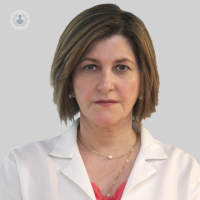5 things about endometriosis
Written by: Endometriosis is a chronic benign disease, inflammatory and causes to appear endometrial tissue outside the endometrium (lining of the inside of the uterus). This disease Gynecological , which affects young women, is characterized by having a hormonal dependence and an uncertain evolution.
Endometriosis is a chronic benign disease, inflammatory and causes to appear endometrial tissue outside the endometrium (lining of the inside of the uterus). This disease Gynecological , which affects young women, is characterized by having a hormonal dependence and an uncertain evolution.
Features endometriosis
Despite being a benign disease, endometriosis can become incapacitating, becoming cause of absenteeism and academic. On the other hand, usually it not easily diagnosed because the symptoms are very unspecific. In fact, it is estimated that patients take between 7 and 12 years to be diagnosed from the onset of symptoms.
Another characteristic of this disease is that 20% of women who have it have no symptoms, so it is even more difficult to diagnose and calculate the frequency of women who suffer. Still, it is estimated that between 5 and 10% of young women and between 35 and 50% of adult women with infertility problems or menstrual pain have endometriosis.
Endometriosis, what are its causes?
There is no clear cause of endometriosis. In the origin of endometriosis they are involved.
- genetic susceptibility
- inducing factors / endocrine disruptors: chemicals outside the human body that alter hormonal balance. They can be toxic or environmental
- Action of estrogens (female hormones)
- Among the theories about the origin of endometriosis, it emphasizes the theory of "retrograde menstruation". It argues that, during menstruation, endometrial tissue is transplanted to other pelvic organs, where they implant and grow. It is the prevailing theory, but does not explain why most women have retrograde menstruation and only some have endometriosis.
Symptoms of endometriosis
The most common symptoms of endometriosis are:
- Pelvic pain: may appear as dysmenorrhea (menstrual pain), the most common, usually secondary (after the first menstrual periods) and can be progressive and severe, even disabling. It may also appear as chronic pelvic pain, unrelated to menstruation. When the endometriosis is severe, the patient may feel pain during sex.
- Pain with defecation: if the disease affects the intestine. Besides pain may have other symptoms (constipation, diarrhea or bleeding in the stool) that can be chronic or cyclical.
- Pain with urination or bleeding in the urine: when endometriosis affects the urinary bladder.
- Other symptoms (depending on where the endometrial tissue is implanted): Sciatica (pain in the sciatic nerve) pain in the abdominal wall in caesarean scar or perineum, among others.
- Psychological disorders: depression, anxiety or lack of sexual desire.
- Sterility is often related to endometriosis, since between 30 and 50% of women with endometriosis have infertility.
In the case of adolescents, symptoms and clinical presentation are very different, requiring a specific treatment. For this reason, it is necessary to be treated by gynecologists specializing in endometriosis.
Diagnosis
First, the diagnosis of endometriosis is based on the medical history of the patient. discomfort when moving the cervix, exploring the utero-sacral ligaments (located next to the cervix) and fixed in position uterus retroversion (backwards): In the pelvic exam typical signs of endometriosis are observed.
Imaging tests are very useful for diagnosing endometriosis:
- Ultrasound can diagnose ovarian endometriomas (endometriotic cysts in the ovaries), deep endometriosis and adenomyosis (endometriosis in the uterus).
- Nuclear magnetic resonance (NMR) can diagnose deep endometriosis, ovarian endometriomas and endometriosis in other locations. MRI can also differentiate endometriomata other types of cysts (dernoide cyst, hemorrhagic cyst or malignant tumor).
To diagnose endometriosis definitively, a biopsy is done by laparoscopy, minimally invasive surgery.
The disease can be classified into three types:
- peritoneal surface endometriosis
- ovarian endometriosis (endometriomas)
- deep endometriosis
To determine the severity of endometriosis, it is classified on a scale from I to IV according to the classification of 1996 ASRM (American Society of Reproductive Medicine) is the most widely used classification.
Treatment
Since endometriosis is a hormone-dependent disease, hormone treatment is essential to treat the disease, in any existing forms: progesterone, danazol, GnRH analogues, gestrinone, oral contraceptives ...
The first medical treatment to indicate the nonsteroidal antiinflammatory drugs, which may be provided alone or in combination oral contraceptives or progestins. If this treatment fails, they may also be prescribed GnRH analogues or resorting to surgery as a last resort.
If the patient has decided to undergo surgery should be aware that:
- We must assess the balance between risk and profit: if surgery is extensive, it can have significant complications and undesirable effects.
- The goal of surgery is the removal of symptoms rather than the disease.
- Surgery should be the last option for the treatment of pain. Only if incapacitates the patient and persistent and suggestive of deep endometriosis. You should always be tested before medical treatment.
- Resorting to specialists in the disease and multidisciplinary team: surgery may affect several organs.
- If endometrioma, surgery is recommended from a certain size, in case of breakage or twisting of endometrioma or suspicious pelvic mass. Endometrioma treatment improves subsequent fertility rates.
- It is not recommended in patients without symptoms or sterility.
There are three types of surgical addresses of the disease:
- Conventional laparoscopic surgery: is suitable for most procedures, even for deep endometriosis.
- Open surgery is recommended for cases of deep endometriosis with implants and severe intestinal or urethral involvement.
- Robot - assisted laparoscopic surgery
After the surgery, the patient may receive a postoperative treatment to lengthen the period of time without disease and delaying relapse, in case of incomplete removal of lesions or severe pelvic pain.
On the other hand, there are a number of complementary treatments to improve the quality of life of patients and applied in a multidisciplinary context together with the specialist gynecologist in endometriosis:
- Assisted reproduction
- Acupuncture
- Rehabilitation and physiotherapy
- sexological therapy
- nutritional and dietary treatment
- Psychology
- Psychiatry
- Pain Clinic
- Support Groups (Patient)


